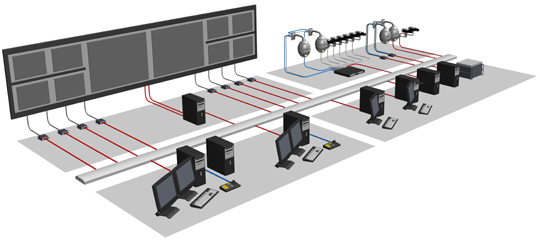Applications and System Design

The heart of the IP Video system is the ‘virtual matrix’. This distributes the digital video signals from the many cameras on the network to the available monitors and recorders as required.
If analog CCTV cameras are used, the analog video from the cameras must be converted to digital data for transmission over the IP network by separate encoders located near the cameras. Alternatively, it is possible to use self-contained IP cameras (which are conventional analog cameras with embedded encoders). Either way, it is the encoded digital video signals that travel over the network.
The virtual matrix also handles processing of alarm signals and access-control data and controls communications via bi-directional audio.
Image Capture and Video Management
At the other end of the chain, the streaming video from the cameras is directed to the various monitors and recorders, controlled by a video-management system. This allows the operator to view and analyze live and recorded video from any camera.
Storage
In contrast to the Digital Video Recorder used with traditional analog systems, the video in an IP-based system is stored on a Networked Video Recorder (NVR). This is a pure software solution that operates on standard platforms with an ‘intelligent’ server PC and a large number of hard disks known as a SCSI (Small Computer System Interface) disk array. The NVR can record from any camera, at any distance, and play back to any monitor. It offers almost unlimited storage of a high number of video channels.
A new form of storage that has been pioneered in CCTV by Bosch is the iSCSI disk array. iSCSI, which stands for IP SCSI, combines the latest technology from the storage and communications worlds: SCSI storage, which uses the SCSI protocol and commands, and the IP network. By transporting SCSI commands over IP networks, iSCSI is able to facilitate data transfers over a network and to manage storage over long distances.
Using the direct-recording-to-iSCSI approach, IP cameras and encoders can stream video data directly to disk, which maximizes a system’s high capacity, hard drive fault tolerance, economies of scale and manageability of storage – all while eliminating the need for NVRs in the system. The iSCSI storage units can, moreover, be located anywhere, either stacked high in a secure centralized IT-managed facility as are conventional NVRs; located in secure cupboards as distributed network-attached storage where they are less vulnerable to a single physical attack; or as direct-attached storage coupled with a Bosch video encoder/decoder.